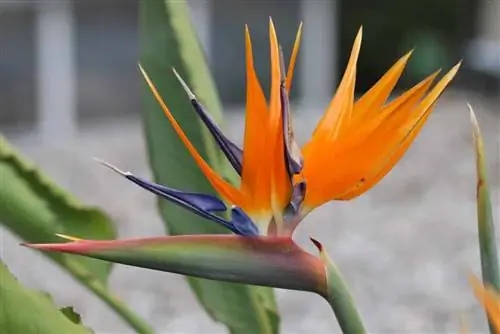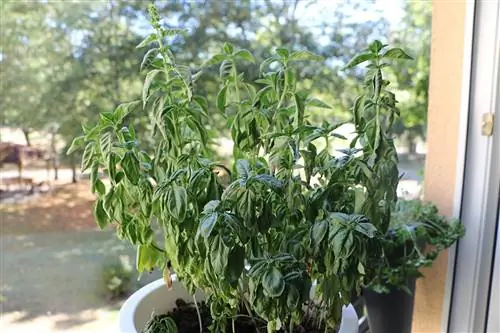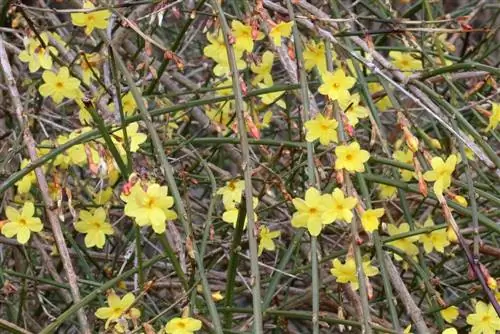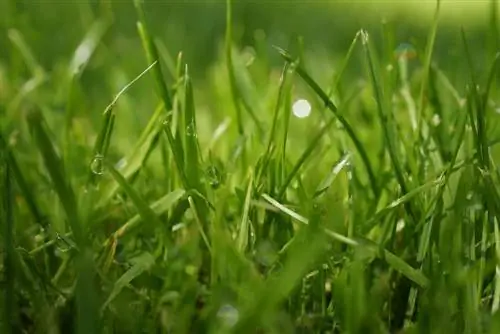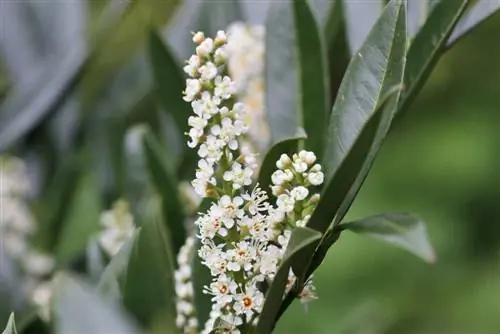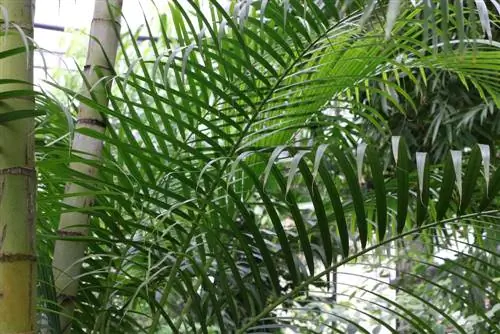- Author admin [email protected].
- Public 2023-12-17 03:39.
- Last modified 2025-01-24 12:45.
Strelitzias originally come from the southern regions of Africa. They first came to Europe in 1773 and were passed on from London to numerous botanical gardens. It didn't take long for the exotic plants, which are also called parrot plants because of their flower shape, to conquer home terraces. With proper care, bird of paradise flowers can survive the winter and bloom indoors under suitable conditions.
Winter rest
The Strelitzia is perennial, but not hardy. She also uses the cooler winter months to gather her strength and form new flowers for the next season. It also switches to low heat in winter because, in addition to the right temperature for flowering, it also doesn't have the right lighting conditions. It therefore makes sense to give the Strelitzia a break in winter.
Nevertheless, you don't have to miss out on the blooms for the entire months leading up to summer. If you provide the plant with suitable conditions, you can enjoy the first flowers in early spring. The situation is somewhat different if the plants are generally kept indoors and are not placed outdoors in summer. In this case, the plants choose the time of their rest phase themselves, which usually begins immediately after the flowering period. However, the rest periods are significantly shorter, which means that the plants can bloom two and sometimes even three times a year.
Winter quarters
So that the plants survive the winter unscathed, it is important to ensure suitable conditions, especially when moving from outdoors to indoors. The ideal winter quarters have the following characteristics:
- Temperature between 10° and 15°C
- bright (no window on the north side)
- average humidity
Strelitzias can tolerate temperatures up to 5°C without any problems, but they need to be watered more frequently. These areas, for example, are suitable as winter quarters:
- Staircase
- Bedroom
- Hallway
- bright and frost-free garages
If there is a change in temperature, the recommended temperatures should be adhered to, because this is the only way the plant can go into hibernation mode and gather enough strength for the next season. From around May it can be put outside again. When overwintering, you should also choose a place where the humidity is not too low. Places above heaters are completely unsuitable. Even Strelizia that are kept as houseplants should not be placed directly above the heater.
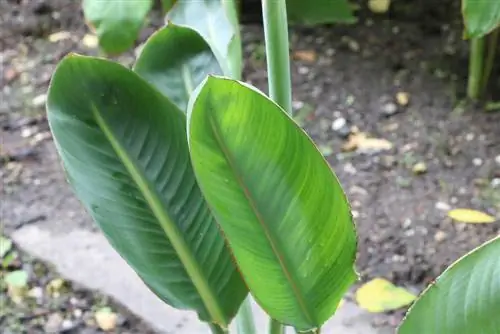
A special case among the possibilities is the winter garden. The plant can be placed in the winter garden from around January. Beforehand, it should also be overwintered in the right conditions. If the plant is placed in the warm and bright winter garden too early, it can cause flowering stress. This means that in summer the flowering is significantly smaller or even non-existent.
Tip:
The Strelitzias can also be kept in the winter garden all year round and create a tropical ambience.
The Strelitzia can also be overwintered in a greenhouse for a limited time. Since the plant is not hardy, the greenhouse must be frost-free.
Preparing plants
If the plants come from the terrace into the winter quarters, they should be checked in advance to see whether there are any pests on them or whether they may have diseases. Infected or diseased parts of the plant are removed; if there is a problematic infestation such as scale insects or aphids, these must first be combated before the plant goes into winter quarters. Otherwise, pests or diseases can spread to other plants.
Tip:
It is not uncommon for diseases or pests to be found in the top layer of soil. Before the Strelitzia moves to its winter quarters, this layer is removed about 1 - 2 cm and replaced with potting soil.
He althy plants are then freed from old or dead plant parts. Spent flowers are cut off and old brown leaves are also removed. Now the plants are optimally prepared for winter quarters.
Pouring
Strelitzias are evergreen and need sufficient water to maintain their leaves in winter. The root ball must always be moist, but the top layer of soil may occasionally dry out. In any case, waterlogging must be avoided, as this can cause the roots to rot, which leads to the death of the plant.
Tip:
Pour in small amounts, but often. This prevents waterlogging from forming, but the root ball never dries out completely and you can check the plant more regularly for pest infestation or diseases.
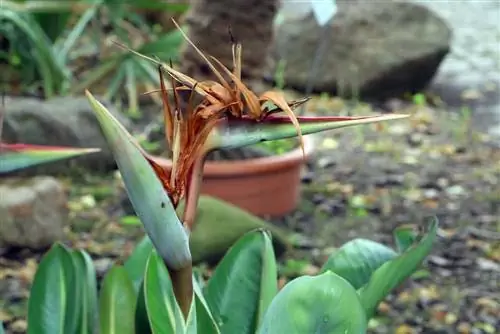
The Strelizia can be overwintered without any problems up to a temperature of 5°C. However, the amount of watering or the frequency of watering must be increased if the strelicia are overwintered at temperatures below 10°C. The water requirement is significantly higher at cooler temperatures and if there is a shortage, the plant does not produce as many flowers or the leaves die.
Fertilize
During the hibernation period, fertilization should be completely avoided. This would only result in it producing lots of leaves but no flowers. The first fertilizer applications can only begin in late spring. A liquid fertilizer for flowering plants is ideal.
Repotting
Since the plant is not hardy, it only comes out of its winter quarters when there is no longer any danger of frost. However, before it goes outdoors again, it will be repotted if necessary. You should repot the plants in the following cases:
- Pot was too small
- Plant should be divided
- Pest or disease infestation in winter quarters
The new pot should be at least twice as big as the previous root ball. This will ensure there is enough room to spread it out again. If the plant is repotted due to pests and diseases, a new pot with a saucer should be used. Pests and diseases can remain on the pot and are thus transferred back to the new substrate or plant. To ensure that the plants have a good start to the new season, a suitable substrate should be used. This is a mix of:
- clay soil
- Lauberde
- Compost soil
- rotten manure
- Sand
The individual ingredients are mixed in equal parts, although the proportion of sand can be slightly smaller.
Tip:
After repotting, do not put the Strelitzia outdoors in the blazing sun. Slowly acclimate the plants to direct sun, otherwise sunburn can occur on the leaves.
Diseases and pests
Some diseases and pests can be dangerous for the Strelitzia in its winter quarters. The plant should therefore be checked regularly when watering. The most common dangers in winter quarters include:
- Aphids
- Mealybugs
- Scale insects
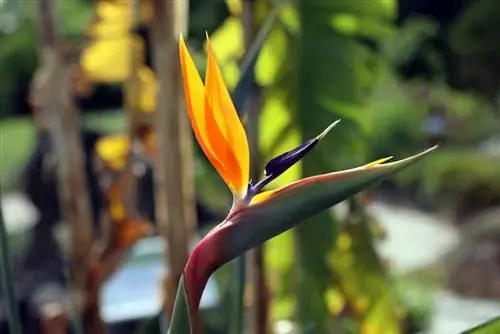
If the Strelitzia is too warm during the winter, the Septoria fungus can also form on the leaves. This can be recognized by rust-red spots on the leaves. Affected leaves are removed immediately and the plant should be placed in a place in the optimal temperature range for the winter. Different types of lice should be combated early on. Sometimes it is enough to place the plants in the shower at a slight angle and shower the leaves so that the water does not run into the pot, but directly into the shower tray. As a preventive measure, the plant can also be sprayed every few weeks with a decoction of lavender flowers. The decoction has a limited effect against fungal infections and can also scare away the pests so that they do not settle on the plant in the first place.
Care errors in the winter quarters
One reason why the Strelitzia does not survive the winter in its quarters is care errors, which it cannot or only with difficulty cope with during the winter rest. The following problems should be avoided:
- Draft
- Waterlogging
- humidity too high or too low
Drafts can always become a problem, especially when wintering in stairwells. Since the plants are not hardy, they are very sensitive to cold air. As soon as the outside temperature drops below 5°C, the plant must be protected from drafts.
Another problem is humidity, which is difficult to maintain indoors. It is usually far too dry because the heating dries the air. To counteract this to a limited extent, water bowls can be placed around the plants. However, no standing water should form in the saucers as waterlogging can lead to root rot. In very dry rooms, water bowls usually no longer help and the leaves have to be sprayed regularly.

